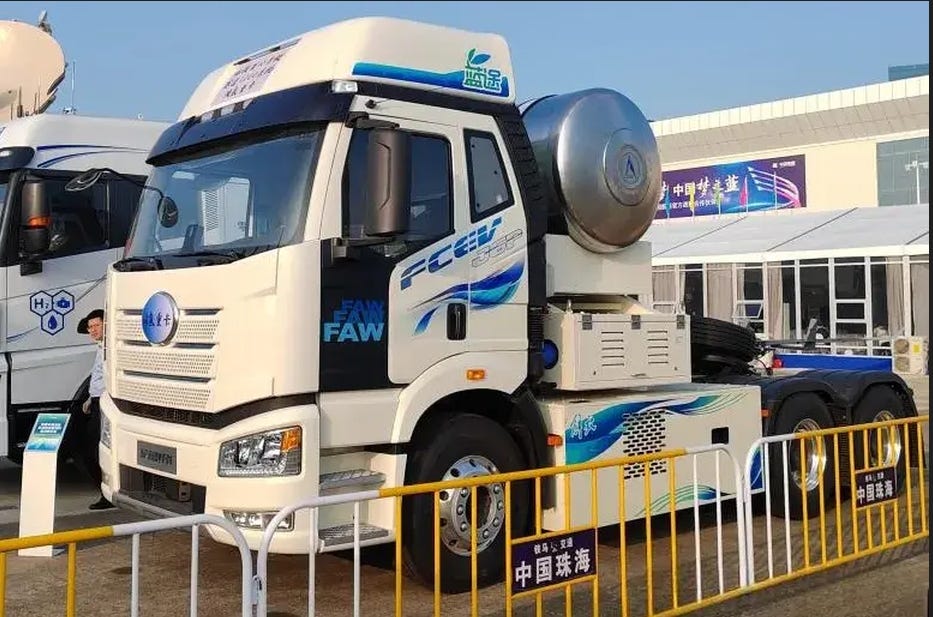Momentum Builds Across the Globe for Hydrogen Innovation
This week’s newsletter showcases how global efforts are converging to advance hydrogen technology. From Namibia’s green hydrogen breakthrough to China’s liquid hydrogen transport leap, and Europe’s investments in mobility and clean fuels, the pace of innovation is unmistakable.
Namibia’s HyIron Plant Produces First Hydrogen – A Milestone in Green Iron Production
Namibia has achieved a landmark milestone in Africa’s hydrogen journey with HyIron’s new plant producing its first green hydrogen. This facility is part of a broader initiative to revolutionize iron production using renewable energy and hydrogen, replacing coal in the traditional blast furnace process. The plant aims to produce green iron for export, aligning with Europe’s decarbonization goals and boosting Namibia’s role in the global green supply chain.
The project not only showcases Africa’s emerging position in the hydrogen economy but also emphasizes the importance of decentralizing hydrogen production. It supports regional energy independence and creates jobs while adhering to strict sustainability principles. Namibia’s abundant solar resources give it a natural edge in green hydrogen, and the HyIron plant is set to become a case study for future hydrogen-based industrial production worldwide. (https://www.h2-view.com/story/hyirons-namibia-plant-produces-first-hydrogen-ahead-of-green-iron-production/2123349.article/)
China’s Track 1000 Liquid Hydrogen System for Trucks Breaks 1,000km Barrier
China has unveiled a groundbreaking innovation in heavy-duty transportation: the Track 1000 liquid hydrogen fuel system, which allows trucks to travel over 1,000 kilometers on a single refueling. This technology could redefine long-haul freight by offering extended range, rapid refueling, and significantly lower emissions.
The Track 1000 is part of China’s broader push to lead in clean transport technologies. By utilizing liquid hydrogen, it sidesteps many limitations associated with compressed hydrogen storage, such as volume and pressure concerns. It also offers improved energy density and operational efficiency, making it a strong alternative to battery-electric trucks in demanding logistics scenarios.
This development may pave the way for hydrogen trucks to compete on both cost and performance with diesel, particularly in markets with large distances and high cargo loads. If widely adopted, Track 1000 could play a vital role in decarbonizing road freight, a sector responsible for significant global emissions. (https://fuelcellsworks.com/2025/03/21/clean-energy/china-unveils-track-1000-liquid-hydrogen-system-for-trucks-breaking-1-000km-barrier-without-refueling)
Farnborough Airport Secures Landmark Deal for Hydrogen-Derived SAF
In the UK, Farnborough Airport has signed a transformative agreement with a hydrogen refinery to source 12.5 million litres of Sustainable Aviation Fuel (SAF) made from locally produced hydrogen. This deal marks one of the largest SAF commitments from a private airport and a major step toward greener aviation.
The fuel will be produced using green hydrogen and carbon capture technologies, representing a cleaner alternative to conventional jet fuel. It is expected to reduce lifecycle emissions by up to 80%. Farnborough, already recognized for its environmental efforts, aims to become a model for regional airports by demonstrating the commercial viability of hydrogen-based SAF.
This partnership underlines how the hydrogen value chain is extending into hard-to-decarbonize sectors like aviation. By prioritizing local production, the deal also reduces reliance on global supply chains and sets a precedent for sustainable, circular fuel sourcing. (https://fuelcellsworks.com/2025/03/21/clean-technology/farnborough-airport-secures-landmark-deal-with-hydrogen-refinery-for-12-5m-litres-of-locally-produced-saf)
Croatia Grants €15 Million to INA for Hydrogen Production Project
Croatia has approved a €15 million grant to national oil company INA for the development of a hydrogen production facility. This investment will be channeled into creating a hydrogen hub at INA’s existing industrial site, with a focus on producing low-carbon hydrogen for mobility and industrial uses.
The project represents Croatia’s efforts to diversify its energy sources and align with the EU’s broader Green Deal targets. INA’s hydrogen will primarily support public transportation, aiming to deploy hydrogen-powered buses and refueling stations across urban areas. It will also provide clean fuel for industrial partners looking to decarbonize their operations.
Beyond infrastructure, the project will have a long-term impact on Croatia’s clean energy workforce, creating new technical roles and stimulating demand for local hydrogen innovation. This move could also position INA as a regional leader in clean hydrogen, encouraging cross-border cooperation in the Balkans. (https://fuelcellsworks.com/2025/03/21/h2/croatia-to-grant-15-mln-euro-to-ina-for-hydrogen-project)
Levidian and Graphmatech Team Up to Boost Graphene-Hydrogen Synergies
British clean-tech firm Levidian and Swedish materials specialist Graphmatech have announced a strategic partnership to explore the use of graphene to enhance hydrogen systems. Graphene’s unique properties—exceptional conductivity, strength, and thermal resistance—make it an ideal material for next-gen hydrogen infrastructure.
The collaboration aims to improve the durability and efficiency of hydrogen storage tanks, fuel cells, and pipelines. By integrating graphene into these systems, the companies hope to reduce maintenance costs, extend equipment life, and improve overall system performance.
This partnership is particularly significant as the hydrogen economy scales and requires materials that can handle extreme conditions. If successful, the integration of graphene could lead to the development of lighter, safer, and more robust hydrogen technology—benefiting applications ranging from transportation to grid-scale storage. (https://fuelcellsworks.com/2025/03/21/clean-energy/levidian-and-graphmatech-partner-to-advance-graphene-applications-for-a-clean-hydrogen-future-and-beyond)
Conclusion
From Africa to Asia to Europe, the hydrogen landscape is being shaped by bold investments, innovative technologies, and cross-sector collaboration. Whether it’s advancing green iron in Namibia, liquid hydrogen trucks in China, or graphene-enhanced systems in Europe, hydrogen is steadily becoming a cornerstone of global decarbonization efforts.
Stay with us for more updates as the hydrogen economy continues to accelerate.




